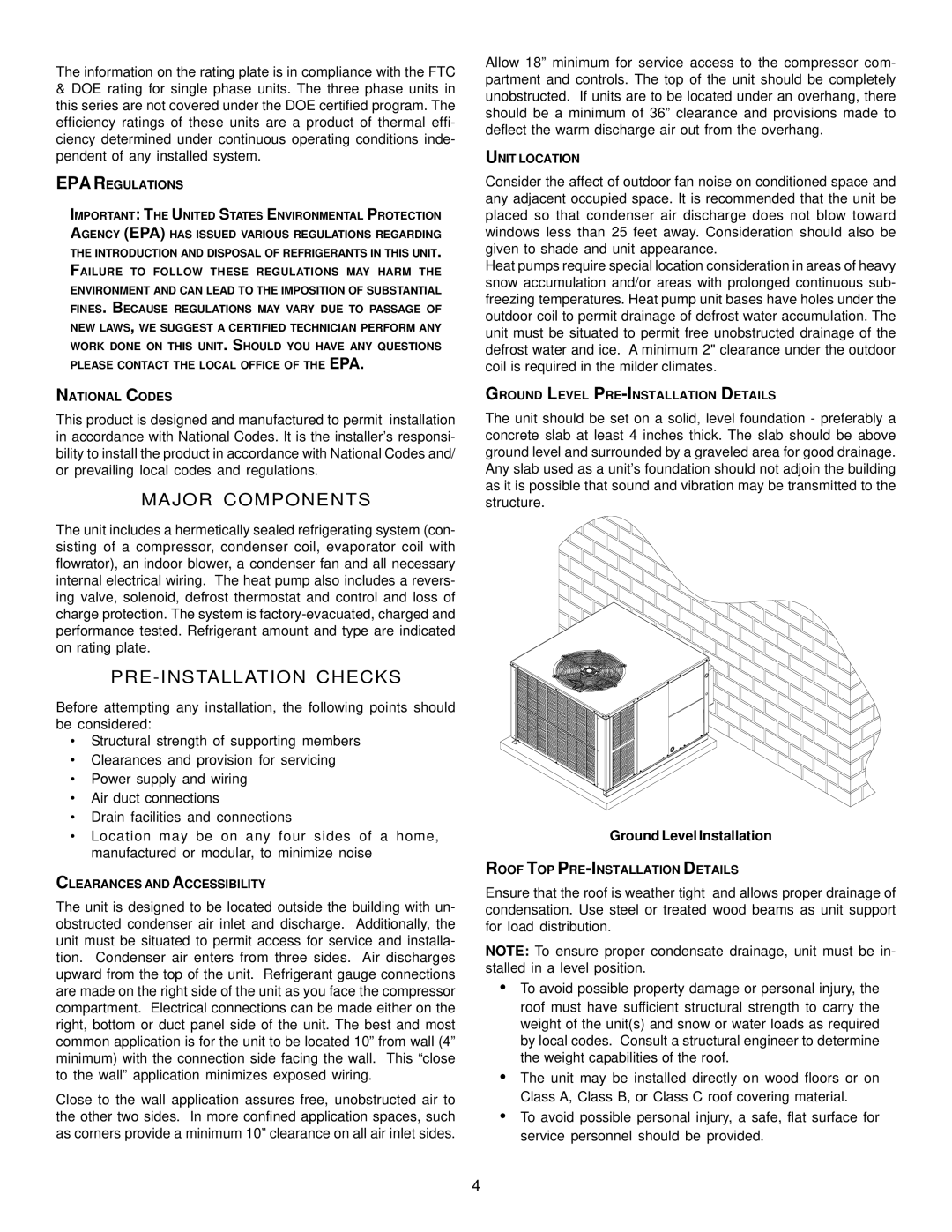
The information on the rating plate is in compliance with the FTC
&DOE rating for single phase units. The three phase units in this series are not covered under the DOE certified program. The efficiency ratings of these units are a product of thermal effi- ciency determined under continuous operating conditions inde- pendent of any installed system.
EPA REGULATIONS
IMPORTANT: THE UNITED STATES ENVIRONMENTAL PROTECTION AGENCY (EPA) HAS ISSUED VARIOUS REGULATIONS REGARDING THE INTRODUCTION AND DISPOSAL OF REFRIGERANTS IN THIS UNIT. FAILURE TO FOLLOW THESE REGULATIONS MAY HARM THE ENVIRONMENT AND CAN LEAD TO THE IMPOSITION OF SUBSTANTIAL FINES. BECAUSE REGULATIONS MAY VARY DUE TO PASSAGE OF NEW LAWS, WE SUGGEST A CERTIFIED TECHNICIAN PERFORM ANY WORK DONE ON THIS UNIT. SHOULD YOU HAVE ANY QUESTIONS PLEASE CONTACT THE LOCAL OFFICE OF THE EPA.
NATIONAL CODES
This product is designed and manufactured to permit installation in accordance with National Codes. It is the installer’s responsi- bility to install the product in accordance with National Codes and/ or prevailing local codes and regulations.
MAJOR COMPONENTS
The unit includes a hermetically sealed refrigerating system (con- sisting of a compressor, condenser coil, evaporator coil with flowrator), an indoor blower, a condenser fan and all necessary internal electrical wiring. The heat pump also includes a revers- ing valve, solenoid, defrost thermostat and control and loss of charge protection. The system is
PRE-INSTALLATION CHECKS
Before attempting any installation, the following points should be considered:
•Structural strength of supporting members
•Clearances and provision for servicing
•Power supply and wiring
•Air duct connections
•Drain facilities and connections
•Location may be on any four sides of a home, manufactured or modular, to minimize noise
CLEARANCES AND ACCESSIBILITY
The unit is designed to be located outside the building with un- obstructed condenser air inlet and discharge. Additionally, the unit must be situated to permit access for service and installa- tion. Condenser air enters from three sides. Air discharges upward from the top of the unit. Refrigerant gauge connections are made on the right side of the unit as you face the compressor compartment. Electrical connections can be made either on the right, bottom or duct panel side of the unit. The best and most common application is for the unit to be located 10” from wall (4” minimum) with the connection side facing the wall. This “close to the wall” application minimizes exposed wiring.
Close to the wall application assures free, unobstructed air to the other two sides. In more confined application spaces, such as corners provide a minimum 10” clearance on all air inlet sides.
Allow 18” minimum for service access to the compressor com- partment and controls. The top of the unit should be completely unobstructed. If units are to be located under an overhang, there should be a minimum of 36” clearance and provisions made to deflect the warm discharge air out from the overhang.
UNIT LOCATION
Consider the affect of outdoor fan noise on conditioned space and any adjacent occupied space. It is recommended that the unit be placed so that condenser air discharge does not blow toward windows less than 25 feet away. Consideration should also be given to shade and unit appearance.
Heat pumps require special location consideration in areas of heavy snow accumulation and/or areas with prolonged continuous sub- freezing temperatures. Heat pump unit bases have holes under the outdoor coil to permit drainage of defrost water accumulation. The unit must be situated to permit free unobstructed drainage of the defrost water and ice. A minimum 2" clearance under the outdoor coil is required in the milder climates.
GROUND LEVEL
The unit should be set on a solid, level foundation - preferably a concrete slab at least 4 inches thick. The slab should be above ground level and surrounded by a graveled area for good drainage. Any slab used as a unit’s foundation should not adjoin the building as it is possible that sound and vibration may be transmitted to the structure.
Ground Level Installation
ROOF TOP
Ensure that the roof is weather tight and allows proper drainage of condensation. Use steel or treated wood beams as unit support for load distribution.
NOTE: To ensure proper condensate drainage, unit must be in- stalled in a level position.
•To avoid possible property damage or personal injury, the roof must have sufficient structural strength to carry the weight of the unit(s) and snow or water loads as required by local codes. Consult a structural engineer to determine the weight capabilities of the roof.
•The unit may be installed directly on wood floors or on Class A, Class B, or Class C roof covering material.
•To avoid possible personal injury, a safe, flat surface for service personnel should be provided.
4
